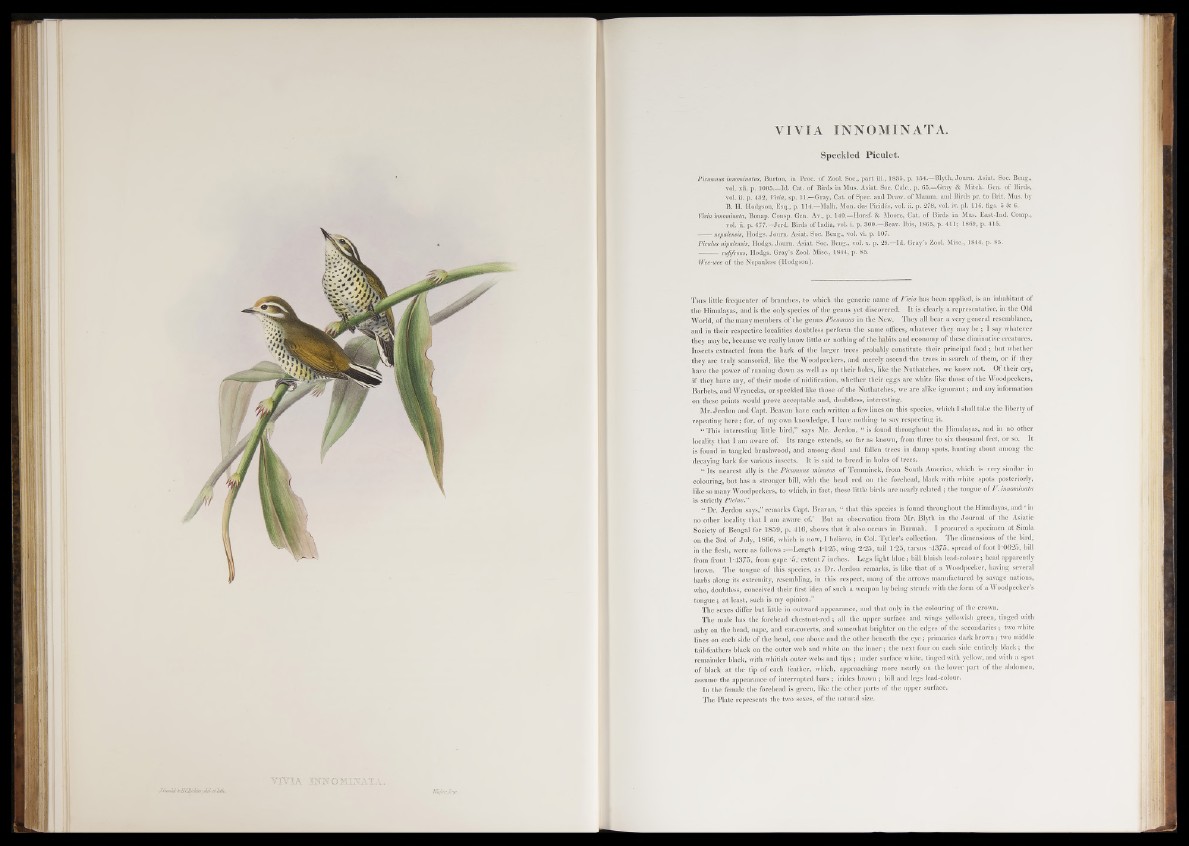
VIVIA INNOMINATA.
Speckled Piculet.
Picumnus innominatus, Burton, in Proc. of Zool. Soc., part iii., 1835, p. 154.—Blyth, Journ. Asiat. Soc. Beng.,
vol. xii. p. 1005.—Id. Cat. o f Birds in Mus. Asiat. Soc. Calc., p. 65.—Gray & Mitch. Gen. of Birds,
vol. ii. p. 432, Vivia, sp. 11.—Gray, Cat. of Spec, and Draw, o f Mamm. and Birds pr. to Brit. Mus. by
B. H. Hodgson, Esq., p. 114.—Malh. Mon. des Picides, vol. ii. p. 278, vol. iv. pi. 116. figs. 5 & 6.
Vivia innominata, Bonap. Consp. Gen. Av., p. 140.—Horsf. & Moore, Cat. of Birds in Mus. East-Ind. Comp.,
vol. ii. p. 677.—Jerd. Birds of India, vol. i. p. 300.—Beay. Ibis, 1865, p. 411; 1869, p. 415.
nepalensis, Hodgs. Journ. Asiat. Soc. Beng., vol. vi. p. 107.
Piculus nipalensis, Hodgs. Journ. Asiat. Soc. Beng., vol. x. p. 29.—Id. Gray’s Zool. Misc., 1844, p. 85.
rufifrons, Hodgs. Gray’s Zool. Misc., 1844, p. 85.
Wee-wee of the Nepaulese (Hodgson);
T his little frequenter of branches, to which the generic name of Fima has been applied, is an inhabitant of
the Himalayas, and is the only species o f the genus yet discovered. It is clearly a representative, in the Old
World, of the many members of the genus Picumnus in the New. They all bear a very general resemblance,
and in their respective localities doubtless perform the same offices, whatever they may be ; I say whatever
they may be, because we really know little or nothing of the habits and economy o f these diminutive creatures.
Insects extracted from the bark of the larger trees probably constitute their principal food ; but whether
they are truly scansorial, like the Woodpeckers, and merely ascend the trees in search of them, or if they
have the power o f running down as well as up their boles, like the Nuthatches, we know not. Of their cry,
if they have any, of their mode of nidification, whether their eggs are white like those of th.e Woodpeckers,
Barbets, and Wrynecks, or speckled like those of the Nuthatches, we are alike ignorant; and any information
on these points would prove acceptable and, doubtless, interesting.
Mr. Jerdon and Capt. Beavan have each written a few lines on this species, which I shall take the liberty of
repeating here; for, of my own knowledge, I have nothing to say respecting it.
“ This interesting little bird,” says Mr. Jerdon, “ is found throughout the Himalayas, and in no other
locality that I am aware of. Its range extends, so far as known, from three to six thousand feet, or so. It
is found in tangled brushwood, and among dead and fallen trees in damp spots, hunting about among the
decaying bark for various insects. It is said to breed in holes of trees.
“ Its nearest ally is the Picumnus minutus o f Temminck, from South America, which is very similar in
colouring, but has a stronger bill, with the head red on the forehead, black with white spots posteriorly,
like so many Woodpeckers, to which, in fact, these little birds are nearly related ; the tongue of V. innominata
is strictly Picine.”
“ Dr. Jerdon says,” remarks Capt. Beavan, “ that this species is found throughout the Himalayas, and ‘ in
no other locality that I am aware of.’ But an observation from Mr. Blyth in the Journal of the Asiatic
Society of Bengal for 1859, p. 416, shows that it also occurs in Burmah. I procured a specimen at Simla
on the 3rd of July, 1866, which is now, I believe, in Col. Tytler’s collection. The dimensions of the bird,
in the flesh, were as follows Length 4-125, wing 2-25, tail 1-25, tarsus -4375, spread of foot 1-0625, bill
from front 1-4375, from gape -5,1 extent 7 inches. Legs light b lue; bill bluish lead-colour; head apparently
brown. The tongue of this species, as Dr. Jerdon remarks, is like that of a Woodpecker, having several
barbs along its extremity, resembling, in this respect, many o f the arrows manufactured by savage nations,
who, doubtless, conceived their first idea of such a weapon by being struck with the form of a Woodpecker’s
tongue; at least, such is my opinion.”
The sexes differ but little in outward appearance, and that only in the colouring of the crown.
The male has the forehead chestnut-red ; all the upper surface and wings yellowish green, tinged with
ashy on the head, nape, and ear-coverts, and somewhat brighter on the edges of the secondaries; two white
lines on each side of the head, one above and the other beneath the eye; primaries dark brown; two middle
tail-feathers black on the outer web and white on the inner; the next four on each side entirely black; the
remainder black, with whitish outer webs and tips ; under surface white, tinged with yellow, and with a spot
o f black at the tip of each feather, which, approaching more nearly on the lower part of the abdomen,
assume the appearance of interrupted bars ; irides brown ; bill aud legs lead-colour.
In the female the forehead is green, like the other parts of the upper surface.
The Plate represents the two sexes, of the natural size.